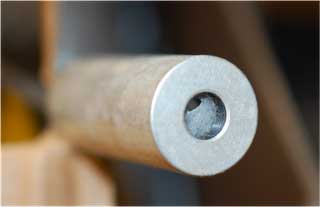Protecting Your Instruments from Spiders, Wasps and Other Pests
When making measurements and carrying out experiments, scientists tend to spend a great deal of time and care in selecting the right instruments, calculating uncertainty, and making sure conditions are acceptable. One of the last things on the minds of most people (and rightfully so) is that a pest, like a spider, could find a way to sabotage an experiment or measurement campaign. As spring approaches, many pests (including our 8-legged friends) will just see the aperture of an infrared radiometer (IRR) as their new comfortable home. There are some simple steps to prevent IRRs from looking like the photo below.

Spider webs can cause inaccurate readouts
Important Steps to preventing sabotage by pests:
- Check sensor often.
- Sensor placement.
- Repellant.
How “often” depends on a couple of factors such as: what the sensor is measuring, whether it is outdoors or indoors, where the sensor is located, etc. For example, if you had an IRR sensor making measurements outdoors and in close proximity to thick shrubbery (spider magnet), you might want to reconsider the location of the IRR. If the location cannot be changed, it would be wise to check it at least weekly. If your sensor is located high on a weather station, which you only visit once a month, it can be helpful to monitor and compare measurements from day to day, if the data acquisition system allows. If you suspect something is wrong with readings, check the IRR next time you go out for a visit. Better safe than sorry.
Choosing and applying a repellant can be tricky. Some commercial repellants can be harmful to humans, due to their potency. They can also be corrosive, which can be detrimental to the longevity of an IRR. Another option is to use essential oils such as lavender, lime, lemon, orange, tea tree, etc., which naturally deter spiders and other pests while being non-toxic to humans. Whichever repellant you select, take all the safety precautions recommended on the container. To apply the repellent, use a cotton swab and carefully rub the repellant on the wall threads of the IRR aperture without touching the sensor window, as this can cause a change in readings. You may need to reapply the repellant occasionally.
In the event you find an unwelcome visitor in an IRR, carefully brush it away with a cloth and carefully clean out any remaining spider webs with a wet cotton swab. If you are already having problems, or anticipate having problems, with other pests like wasps, please read “Minimizing problems with wasps on weather stations” in the knowledge base.
Minimizing Problems with Wasps on Weather Stations
Weather stations can suffer damage or the data can be altered due to pests. Pest issues include anything from Elk rubbing the velvet off their antlers against a station, cattle bumping and damaging a station while grazing, vandalism, bird droppings on light sensors, ice buildup, and wasp nests. Each of these issues can reduce data quality and each has many possible solutions.
Wasps can be a problem for many reasons. In addition to an unpleasant human interaction, wasps like to build nests in confined spaces such as in gill-type temperature shields. These nests block airflow and cause elevated temperature readings. Several steps can reduce wasp nests. First, we have found that plugging all open tubes reduces nests in the end of the cross arms We have found that the short vinyl caps from either http://stockcap.com or http://www.caplugs.com work well to fit snugly over ends of cross arms. If the caps are a bright color, this has the added benefit of high visibility to prevent head bumps. Another effective method to plug tube openings is to put closed-cell foam inside the hollow cavities of cross arms.
Once possible nest locations are reduced, it helps to use spray repellent. Some sprays kill wasps and the residue will linger and prevent wasps from returning. Gill radiation shields can even be sprayed with repellent. While this residue can be washed off with moisture, it still helps.
We have used traps to reduce wasp populations around a station. Traps use an attractant to lure in and trap wasps. This is an effective longer-term solution instead of – or in addition to – spray repellents.
Passive, gill-type temperature shields provide a cavity in which wasps like to build nests. We have found that MetSpec temperature shields have reduced numbers of wasp nests, apparently because the gaps that wasps would use to enter the shield are smaller, making it more difficult, for them to enter. Wasps do not like to build nests in areas that are windy. In our experience, wasps never build nests in aspirated temperature shields.
Getting good data goes far beyond sensor and product selection. Ongoing maintenance, such as checking a gill shield for a wasp nest, is critical to gathering good data. We consistently remind our customers that ensuring sensors are mounted correctly, leveled when needed and cleaned periodically go a long ways to getting better measurements.
